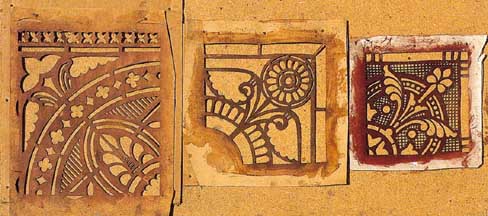Illustrated
Architecture Dictionary ............... Illustrated
FURNITURE Glossary
Stenciling
 ...
... 

Illustrated Architecture Dictionary ............... Illustrated FURNITURE Glossary
Stenciling
...
|
History - furniture The stencil is an age-old tool, and stenciling - the art of applying design to a surface through superimposed openings - is an ancient craft. It originated in various areas at different times and for different purposes. A natural source as simple as the holes in leaves may have provided the first stencils. The Etruscans, of whose earlier civilization so little is known, ornamented their vases through copper stencils. The early Fiji Islanders decorated cloth with stenciled geometric borders; in ancient monasteries we find hand-colored "stamped" Buddhas; in the Caves of a Thousand Buddhas on the Central Asian Silk Road "rows of stenciled Buddhas, dark brown with white draperies on a pale green ground" were uncovered. Japanese craftsmen stenciled designs on fabric and paper, and stenciled their elaborate No robes in gold. Writing was taught with stenciled lettering; the Barbarian kings and Roman emperors signed their names through stencils, and the ecclesiastical insignia IHS was stenciled on altars and vestments. Fifteenth-century playing cards were decorated with stencil designs, and in the late seventeenth century the Frenchman Jean Papillon delighted the world with the first stenciled wallpaper. In England early stenciling served mainly religious purposes. We find it on rood screens, in mural design, and on the garments of saints. In the seventeenth century such ornamenting was flocked onto paper by applying ground wool adhesively to the surface, and may be accepted as the precursor of our own American theorem, or stenciling on velvet. In the early nineteenth century, when inventive American furniture makers were seeking alternatives for all the carving, inlay, and mountings that made European imports so desirable and expensive, they soon discovered that simulating them by the simple procedure of painting - that is to say, by brushing gold powders mixed with turpentine or varnish mediums - did not provide the lustrous effects desired. However, the rubbing in of multicolored bronze powders through stencil openings onto a tacky varnish surface created a burnished tone, and a clever ability to shade and strike sharp divisions off contoured stencil edges, called templets, resulted in a form of ornamentation that became widely acclaimed and was relatively inexpensive and fast - at least by the labor standards of that day. Certainly, for any effort to decorate in quantity as well as quality, stenciling offered a practical method for producing elegant designs where painting did not. The earliest documented American stenciled ornamentation on furniture dates from approximately the time of Lambert Hitchcock's arrival at the Fork-of-the-Rivers in Barkhamsted, Connecticut, in 1818, and he became the outstanding pioneer in its development. History - Hitchcock furniture Painting, graining, stenciling, striping, banding - all these characteristics contributed to the name "Hitchcock" soon becoming a widespread term and ultimately a generic word applied to many early American decorated home furnishings. Lambert Hitchcock's artists were to become known among the best in the New World. Most stenciled chairs, including examples he manufactured as well as Hitchcock-type chairs made elsewhere, were usually painted black; other colors were custom finished to order, probably as the chair moved from the formal elegance of the parlor and dining room to the lighter intimacy of the bedroom. Also bright hues, especially on the plank-seated styles, cheered up many a dreary kitchen. However, some were finished in the natural wood, as noted in an advertisement in 1829, in which B. Hudson had just received "a quantity of Curl Maple Chairs" from Hitchcock's Factory - no paint or decorations whatever.
|
Stained glass
Silkscreen is an example of stencil technique.The second illustration near the top of the page is that of three c. 1890s stencils that were used on stained glass windows to produce grisaille patterns.
Examples from Buffalo:
- Illustration above: Fancy armchair - Private collection
- Fancy armchair - Private collection
- Eli Terry Empire style clock - Boies-Lord House (Hamburg)
- 3 stained glass windows - St. Louis RC Church
- Stained glass windows - Prospect Avenue Baptist Church
- Wall stencil - Assumption RC Church
- Wall stencil - Trible House
- Wall stencil - Hewitt House/Inn Buffalo
